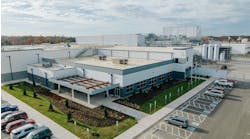With many cutting-edge technologies and concepts, the food & beverage industry has taken a cautious approach. Years ago, a few trailblazers employed that kind of caution on the Industrial Internet of Things (IIoT) — the interconnected network among machinery, sensors and data applications that began to take the larger manufacturing industry by storm.
Today, however, at least some of the food & beverage industry has gotten past dipping its toe into the shallow end of the pool — generally, it has been keeping pace on IIoT, says Scott Sommer, program chair for the Food and Pharmaceutical Industries Division of the International Society of Automation (www.isa.org) and department manager for instrumentation & controls at DPS Group (www.dpsgroupglobal.com).
“Most food and beverage companies have a wealth of capital and brand reputation riding on every batch and every change proposed to their process,” explains Sommer. “While most companies have figured out how to deal with these risks and unknowns, adoption of all the benefits that IIoT has to offer has been slow, but steady.”
Indeed, the numbers reflect a slow-rolling IIoT wave making its way through the general manufacturing space. In Rockwell Automation’s “8th Annual State of Smart Manufacturing Report,” 42% of 1,353 global manufacturers surveyed said their companies had already adopted IIoT. The April 2023 report also showed another 36% of respondents plan to adopt IIoT.
For the food & beverage industry specifically, Food Processing in December 2022 undertook a survey of advanced automation with Augury (www.augury.com), a production health solutions provider. With a base of 161 respondents, 42% said they did not foresee starting a journey to Industry 4.0 “in the immediate future.” Only 2% said they were “pretty far along” on that journey and another 2% said they had fully implemented Industry 4.0.
Sommer’s own assessment rates the food & beverage industry a little higher than those numbers.
“I would say that there are about 25% who are early adopters of these new technologies, 40% who are actively engaged in applying these new technologies, 20% who could be considered late adopters, and 15% who are risk-averse,” he explains. “Overall, the adoption of IIoT has started, but there is a long way to go before the full potential of IIoT in the industry is realized.”
Of course, when suppliers and customers begin jumping in on IIoT and requiring processors to do the same, it becomes more challenging to stay out of the water. This was evident during the May Food Safety Summit in Rosemont, Ill., where a global ingredient supplier (Kerry Ingredients), a distribution/logistics company (Martin Brower) and a ubiquitous, mega-sized restaurant chain (McDonald’s) presented a session on their IIoT and digitization efforts and successes.
The underlying message was clear: IIoT is here now; and it can help processors and stakeholders up and down the supply chain better understand operations and contribute to process improvement decisions.
Sommer believes most food and beverage processors have a formal digital transformation plan defined, and the three companies who presented at the Food Safety Summit made it clear that digitization was a process best completed in bits and pieces, particularly for larger companies.
Roadblocks exist to full adoption, ranging from availability of capital and ROI analyses to regulatory concerns and necessary upgrades to infrastructure (wiring, wireless sensors, robotics, cloud-based applications, etc.). But the industry is working its way around them, dedicated to the long-term plan.
By the end of 2025, 75% of the machines at leading CPGs on average will be capable of collecting critical machine performance data – so predicts a white paper released in May 2021 by PMMI, The Association for Packaging and Processing Technologies (www.pmmi.org), titled “Automation Timeline: The Drive Toward 4.0 Connectivity in Packaging and Processing.”
Retrofitting legacy plants and/or processing lines can grind the project to a halt, but digitization and adoption of IIoT isn’t an overnight plan.
“It has been observed that IIoT technologies have been a big part of new construction of manufacturing capacity, whereas retrofitting of existing facilities takes more planning, since interruption of current production schedules can have a negative short-term effect on operations,” Sommer says. Companies that understand that have a process in place.
One engineering manager at a canned goods processor told PMMI that data-collection capability was part of the capital plan for replacing or upgrading legacy equipment, while another engineer at a beverage company stated that integration was progressing at the rate of two to three lines per year. Piecemealing projects to get the best ROI first has been the norm, according to Sommer — and those successes will show the way for others to follow.
“Engineering and operations personnel have been identifying projects with positive returns that can allow the company to incrementally install these technologies and reap the benefits,” he says. “As some of these technologies, approaches and methodologies mature, adoption by even the risk-averse will be considered, as the significant advantages and benefits realized by companies in their peer group become well-documented.”
Getting in position
For processors just starting the journey, experts caution that IIoT is not something that, on its own, will make a process better or worse: It is a tool to connect manufacturing platforms together and provide nearly real-time data to help achieve an end goal. As with any tool, proper use is required.
“The technology is easy to specify, procure, install and configure; the challenge is, does the company have the necessary resources to operate, analyze and apply continuous improvement to these IIoT strategies?” Sommer says. “This is the aspect of IIoT implementation that is often overlooked. Without the proper human resources, the investment in IIoT will likely not be fully realized.”
Processors should set real goals early on in the planning process, focused on attaining the maximum benefits based on the level of resources available — and then commit to training and hiring the right people to meet the required skill set. Data collection and analysis shouldn’t be a foreign concept to most food and beverage processors; IIoT just ramps up the amount of data and speed at which it is transferred.
Companies also must objectively assess where they are now and understand where they want to end up in time, Sommer relays. Where does the processor need to realize the biggest improvement, and which IIoT strategies will provide that value and further the overall corporate goals? Look at what peers may be doing to overcome obstacles and what the latest, best-in-class solutions may have to offer before trying to take on the entire load in-house.
Of course, with any new technology, process or methodology, questions around risk and cost (versus benefit) always come up for any company. What if the investment in IIoT doesn’t produce the predicted results or takes longer to yield a positive ROI? Are the proper workers trained to use and maintain these new technologies, and what happens if they depart the company or plant?
All of these are valid concerns, Sommer says, and participation by all stakeholders in finding answers is paramount.
“These may not be easy questions to answer or even ask, but processors will benefit the most from IIoT only when they have a realistic plan and have support and buy-in from operations, engineering, quality, regulatory affairs and management,” he says.
By creating the appropriate plans and sticking to them over the long haul, processors can use IIoT technologies to help improve throughput, reduce or eliminate deviations and exceed quality parameters for their products.



